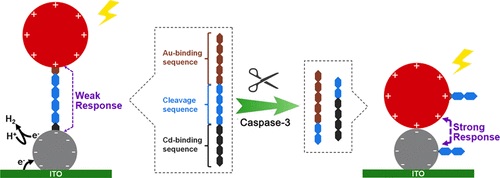戴志晖教授课题组在ANALYTICAL CHEMISTRY发表研究论文
Photoelectrochemical Approach to Apoptosis Evaluation via Multi-Functional Peptide- and Electrostatic Attraction-Guided Excitonic Response
Wang, ZY (Wang, Zhaoyin)[ 1,2 ] ; Liu, J (Liu, Jia)[ 1,2 ] ; Liu, X (Liu, Xin)[ 1,2 ] ; Shi, XY (Shi, Xiaoyu)[ 1,2 ] ; Dai, ZH (Dai, Zhihui)[ 1,2,3 ]*(戴志晖)
[ 1 ] Nanjing Normal Univ, Jiangsu Collaborat Innovat Ctr Biomed Funct Mat, Nanjing 210023, Jiangsu, Peoples R China
[ 2 ] Nanjing Normal Univ, Sch Chem & Mat Sci, Jiangsu Key Lab Biofunct Mat, Nanjing 210023, Jiangsu, Peoples R China
[ 3 ] Nanjing Normal Univ, Ctr Anal & Testing, Nanjing 210023, Jiangsu, Peoples R China
ANALYTICAL CHEMISTRY,201901,91(1),830-835
The excitonic response between nanomaterials is distance-dependent, and thus, interparticle distance is a key factor in fabricating diverse photoelectrochemical (PEC) systems. Current studies focus on DNA-mediated regulation of interparticle distance. However, limited by high demands of base-pairing and flexibility of DNA, it is hard for DNA to achieve precise regulation, especially in a short distance. To pursue better PEC performances in bioanalyses, alternative biological materials should be explored to replace DNA as new "distance controllers". In this work, a peptide with three functional sequences is designed to control interparticle distance between positive-charged Au nanoparticles ((+) AuNPs) and negative charged CdTe quantum dots ((-) CdTe QDs). Relying on the function of binding sequence, (+) AuNPs and (-) CdTe QDs may be separated to a certain distance by the multifunctional peptide. In this case, the excitonic response is relatively weak, and an evident PEC response can be observed. Because it contains the substrate sequence of caspase-3, the peptide is cleaved in the presence of caspase-3. As a result, without the support of intact peptide, electrostatic attraction plays a dominant role, leading to the aggregation of oppositely charged AuNPs and CdTe QDs, which strengthens the excitonic response and attenuates the PEC response. On the basis of these principles, a novel PEC approach was fabricated to sensitively quantify caspase-3. Meanwhile, caspase-3 in staurosporine-treated A549 cells are also determined by the approach, and the obtained results agree well with the fluorescent intensity of confocal images, manifesting that the proposed PEC method can monitor apoptosis in a label-free strategy. Overall, the study reveals the capability of peptides in controlling interparticle distance of nanomaterials, which may accelerate the development of peptide-based PEC analytical methods.

文章链接:
https://pubs.acs.org.ccindex.cn/doi/10.1021/acs.analchem.8b03195
版权与免责声明:本网页的内容由收集互联网上公开发布的信息整理获得。目的在于传递信息及分享,并不意味着赞同其观点或证实其真实性,也不构成其他建议。仅提供交流平台,不为其版权负责。如涉及侵权,请联系我们及时修改或删除。邮箱:sales@allpeptide.com